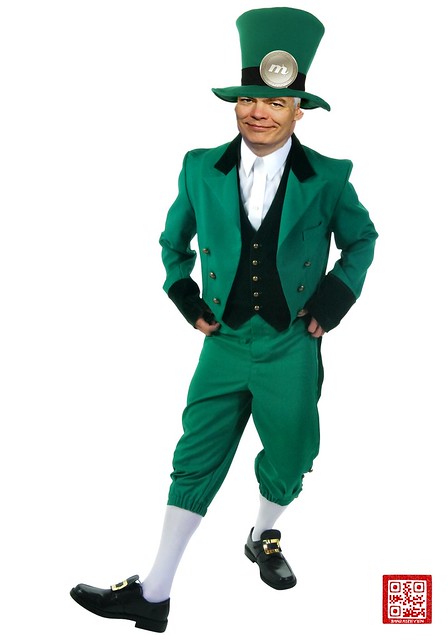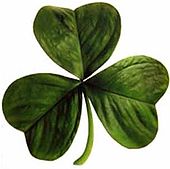Saint
Patrick's Day or the Feast of Saint Patrick (Irish: Lá Fhéile
Pádraig, "the Day of the Festival of Patrick") is a cultural and
religious holiday celebrated annually on 17 March, the death
date of the most commonly-recognised patron
saint of Ireland, Saint
Patrick (c. AD 385–461).
 Saint Patrick's Day was made an official Christian feast day in the early seventeenth century and is
observed by the Catholic Church,
the Anglican
Communion (especially the Church of
Ireland), the Eastern Orthodox
Churchand Lutheran
Church. The day commemorates Saint Patrick and the arrival of Christianity in
Ireland, as well as celebrates the heritage and
culture of the
Irish in general.
Celebrations generally involve public parades and festivals, céilithe, and the
wearing of green attire or shamrocks.
Christians also attend church
services, and the Lenten restrictions on eating and drinking
alcohol are lifted for the day,
which has encouraged and propagated the holiday's tradition of alcohol
consumption.
Saint Patrick's Day was made an official Christian feast day in the early seventeenth century and is
observed by the Catholic Church,
the Anglican
Communion (especially the Church of
Ireland), the Eastern Orthodox
Churchand Lutheran
Church. The day commemorates Saint Patrick and the arrival of Christianity in
Ireland, as well as celebrates the heritage and
culture of the
Irish in general.
Celebrations generally involve public parades and festivals, céilithe, and the
wearing of green attire or shamrocks.
Christians also attend church
services, and the Lenten restrictions on eating and drinking
alcohol are lifted for the day,
which has encouraged and propagated the holiday's tradition of alcohol
consumption.
Much of what is known about St Patrick comes from the Declaration, which was allegedly
written by Patrick himself. It is believed that he was born in Roman
Britain in the fourth century, into
a wealthy Romano-British family. His father was a deacon and his grandfather was a priest in the Christian church. According to
the Declaration, at the age of
sixteen, he was kidnapped by Irish raiders and taken as a slave to Gaelic
Ireland. It says that
he spent six years there working as a shepherd and that during this time he
"found God". The Declaration says that God told Patrick to flee to the
coast, where a ship would be waiting to take him home. After making his way
home, Patrick went on to become a priest.
According
to tradition, Patrick returned to Ireland to convert the pagan Irish to Christianity. The Declaration says that he spent many years envangelizing
in the northern half of Ireland and converted "thousands". Tradition holds that
he died on 17 March and was buried at Downpatrick. Over the
following centuries, many legends grew up around Patrick and he became Ireland's
foremost saint.
Catholic
Church (see calendar), Anglican
Communion (see calendars),
Eastern Orthodox
Church (see calendar), Lutheran
Church (see calendar)
Wearing of the green
On
St Patrick's Day it is customary to wear shamrocks and/or green
clothing or accessories (the "wearing of the
green").
St Patrick is said to have used the shamrock, a three-leaved plant, to explain
the Holy Trinity to the pagan Irish.
This story first appears in writing in 1726, though it may be older. In
pagan Ireland, three was a significant number and the Irish had many triple
deities. The triple
spiral symbol appears at many
ancient megalithic
sites in Ireland.
The colour green has been associated with Ireland
since at least the 1640s, when the green harp flag was used by the Irish Catholic
Confederation. Green ribbons and shamrocks have been worn on St Patrick's Day since at least
the 1680s. Green was adopted as the colour of the Friendly Brothers of
St Patrick, an Irish fraternity founded in about 1750. However, when the Order of St.
Patrick—an Anglo-Irish chivalric order—was
founded in 1783 it adopted blue as its colour. This
led to blue being associated with St
Patrick. In the 1790s, green became associated with Irish nationalism when it was used by the United Irishmen. This
was a republican organization—led mostly by Protestants but
with many Catholic members—who launched a rebellion in
1798 against British rule. The
phrase "wearing of the green" comes from a song of the same
name ***, which laments United Irishmen
supporters being persecuted for wearing green.
Throughout the 19th and 20th centuries, the colour green and its association with Saint Patrick's Day
grew.
|
The Wearing of
The Green
by Dion Boucicault (1820-1890)
|
O Paddy dear, and did you hear the news that going round? The shamrock is forbid by law to grow on Irish ground; St. Patrick's Day no more we'll keep, his colours can't be seen, For there's a bloody law against the wearing of the green. I met with Napper Tandy and he took me by the hand, And he said, "How's poor old Ireland, and how does she stand?" She's the most distressful counterie that ever yet was seen, And they're hanging men and women for the wearing of the green. Then since the colour we must wear is England's cruel red, Sure Ireland's sons will ne'er forget the blood that they have shed. You may take a shamrock from your hat and cast it on the sod, It will take root and flourish there though underfoot it's trod. When law can stop the blades of grass from growing as they grow, And when the leaves in summer-time their verdure dare not show, Then will I change the colour that I wear in my caubeen But 'till that day, please God, I'll stick to wearing of the green. But if at last our colour should be torn from Ireland's heart, Our sons with shame and sorrow from this dear old isle will part; I've heard a whisper of a land that lies beyond the sea Where rich and poor stand equal in the light of freedom's day. O Erin, must we leave you driven by a tyrant's hand? Must we ask a mother's blessing from a strange and distant land? Where the cruel cross of England shall nevermore be seen, And where, please God, we'll live and die still wearing of the green! |
COMMENTS
Dion Boucicault was, despite his French name, an Irishman born in Dublin, a playwright. At the time, inspired by America's successful revolution against British rule, many Irish thought the time was ripe for independence. The colour green became a symbol of sympathy for Irish independence, and the British actually began executing persons found wearing anything of the colour green.
The pen, however, is mightier than the sword, and this powerful poem was the response. Napper Tandy, mentioned in the poem, was in fact a shopkeeper in Dublin who, having been identified by the British as a freedom fighter, had to flee to France. And Boucicault himself fled the country, coming to America as the words of his poem itself echo prophetic.
Boucicault did not stop writing plays, poetry and music on his arrival in New York. One of his better-known works, written over a century ago, is the well-known song, Sidewalks of New York.
His The Wearing of the Green is the music and poetry of which revolution was born.
Boucicault, source: http://www.franks.org/fr01068.htm
To view a Thomas Moore poem, click here: http://www.franks.org/fr01064.htm.
To return to related writings, click here: http://www.franks.org/fr01056.htm.
And, my favorite :
[minstrels] The
Second Coming (poem, W.B.
Yeats)
Turning and turning in the widening gyre
The falcon cannot hear the falconer;
Things fall apart; the centre cannot hold;
Mere anarchy is loosed upon the world,
The blood-dimmed tide is loosed, and everywhere
The ceremony of innocence is drowned;
The best lack all conviction, while the worst
Are full of passionate intensity.
Surely some revelation is at hand;
Surely the Second Coming is at hand.
The Second Coming! Hardly are those words out
When a vast image out of Spiritus Mundi
Troubles my sight: somewhere in sands of the desert
A shape with lion body and the head of a man,
A gaze blank and pitiless as the sun,
Is moving its slow thighs, while all about it
Reel shadows of the indignant desert birds.
The darkness drops again; but now I know
That twenty centuries of stony sleep
Were vexed to nightmare by a rocking cradle,
And what rough beast, its hour come round at last,
Slouches towards Bethlehem to be born?
-- William Butler Yeats
|
poem reposted
from: http://773.harrold.org/yeats.html
linked from:
http://harrold.org/rfhextra/books.html
 Harrolds.Blogspot.com
Harrolds.Blogspot.com



No comments:
Post a Comment
Please, avoid posting advertisements. Content comments are welcomed, including anonymous. Posts with profanity will not be published.